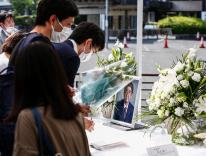FROM THE HEARTLAND
Just a note (from the heartland) to thank you for publishing three careful and doucmented views on whether the Catholic Theological Society of America is a “wasteland” (“How Catholic is the CTSA?” March 27).
In any healthy family, school, university, or human association serious, thoughtful dialogue ought to be admired and encouraged. Thank you for helping us do that, vis-à-vis the CTSA, as we try to balance our God-given rationality and our respect for the magisterium of our beloved church.
James P. Shannon
Wayzata, Minn.
BOSTON COLLEGE I
Congratulations to Commonweal for providing what the 1997 CTSA Convention conspicuously failed to provide: a robust and critical exchange of theological views.
The responses to the major papers were little more than résumés or endorsements that merely reinforced the direction that Peter Steinfels rightly characterizes as being “away from positions taken from Trent through Vatican II and toward positions much more congenial to the Reformers and in general to their liberal and low-church descendants.”
However, as one who was an active participant in the convention, I want to suggest that the “unacknowledged grid” that Steinfels found operative runs deeper than the issue of the ordination of women (important as this undoubtedly was). I locate it in the growing substitution of generic appeals to the Spirit in place of the very particular appeals to Jesus Christ as Lord. This better accounts for the multifaceted “diffusion” that Steinfels acutely perceives. Loss of Christological normativity both propels and rationalizes the drift away from the words of eucharistic institution, away from the acknowledgment of the distinct sacramentality of holy orders, away from full Catholic communion and toward a quasi-autonomous congregationalism. Justice demands acknowledgment of the clearly Christocentric “Presidential Address” of outgoing CTSA President William Thompson. But his address, at once steeped in the Tradition and creative, was not representative of the convention’s direction, nor, alas, does it appear to herald the Society’s future. Like Dulles and Steinfels, I am less than thrilled at the prospect before us. What, then, is to be done?
(Rev.) Robert P. Imbelli
Boston, Mass.
The writer is professor of theology at Boston College.
BOSTON COLLEGE II
Mary Ann Donovan and Peter Steinfels responded fairly and effectively to the attack of Avery Dulles on the CTSA.
I only want to add that, if one desires to size up the current state of the CTSA, one needs to survey the plenary addresses of the past several years, not those of any one year in isolation. (It is the prerogative and duty of the president-elect each year to select and invite plenary speakers, usually to reflect his or her own theological expertise and commitments.)
Moreover, one would have to consider the variety of workshops, panels, papers, and ongoing seminars and research groups, whose activities help constitute the organization. One can certainly find there represented more than one theological, ecclesial, and political standpoint. On the one hand, the 1997 convention saw essentially receptive discussion of a report highlighting the disputed nature of the authority of a Vatican statement on women’s ordination. On the other, the same convention featured a panel discussion of Cardinal Joseph Bernardin’s “Catholic Common Ground Initiative,” at which Archbishop Oscar Lipscomb (chair) was a presenter. A recent letter from CTSA President Mary Ann Donovan informed members that a CTSA research group on “family as domestic church,” formed in 1993 at the request of Cardinal Bernardin (then chairman of the NCCB Committee on Marriage and Family Life), has completed its work, work largely carried out in sessions at the annual meetings.
I think it is true that few in attendance at CTSA conventions are in total agreement with magisterial teaching on every issue, and that most are advocates of strong lay participation (along with clergy) in Catholic theology and ministry. This was reflected in the 1997 plenary addresses on the Eucharist. And, on these issues, CTSA members do not seem at great variance with the U.S. Catholic laity generally, especially those in their fifties and younger (see Dean R. Hoge, “Get Ready for the Post-Boomer Catholics,” America, March 21, 1998).
Those who want the CTSA to consider more or different views should attend the conventions; participate actively in sessions; submit scholarly proposals to our program committee; and concentrate more on positive advocacy for their own take on Catholic tradition than on labeling their colleagues’ endeavors a “wasteland.”
Lisa Sowle Cahill
Boston, Mass.
The writer is professor of theology at Boston College and past president of the CTSA (1992–93).
BOSTON COLLEGE III
As one who attended the CTSA convention last June, I concur fully with the stark assessment of Father Avery Dulles. Sister Mary Ann Donovan falsely claims that the committee’s statement contradicting the Responsum of the Congregation for the Doctrine of the Faith on the impossibility of ordaining women, and the CTSA in approving the resolution supporting the statement so overwhelmingly, “do not collectively oppose anything.” At the meeting where the committee presented its statement to the convention, Sister Catherine Hilkert of Notre Dame, a committee member, stated publicly that “our task was to refute the Vatican document.”
Nor is the CTSA statement, as Peter Steinfels avers, respectful, responsible, and conservative. If it were, the committee would have had some members who could have argued for the full Vatican position stated in Ordinatio sacerdotalis and the Responsum. In fact not one member of the committee accepted the full Vatican position. It was anything but respectful and responsible. As several colleagues mentioned to me sadly at the time, it was more like a kangaroo court where scholarly objectivity and Catholic wisdom were set aside for biased political advocacy. I challenge any member of that committee to state publicly that he or she accepted the full Vatican position and argued for it. Everyone knows there was not one, not even one.
So this committee and the resulting statement unfortunately illustrates plainly the truth of Cardinal Bernard Law’s judgment that the CTSA “has become an association of advocacy for theological dissent.” As for the metaphor of “wasteland,” Dulles’s criticisms of the presentations are on target. The keynote presentations, as well as other publications of the presenters, indicate a lack of the intellectual habits needed to understand the theoretical achievements of, for example, the eucharistic theology of Thomas Aquinas influencing the doctrines of the Council of Trent. As Bernard Lonergan insisted, without attaining the intellectual conversion underlying the theoretical achievements of Aquinas, the efforts of contemporary theologians to present the history of Catholic doctrine and theology will fall into historicism and relativism. As I have argued elsewhere (see, America, May 26, 1990 and Crisis, December 1997, February 1998), there is much more that Catholic graduate programs should be doing to hand on the intellectual virtues and skills needed to measure up to the great achievements of Catholic wisdom and theology. It is a sign of what Lonergan called “the impoverishment of contemporary theology” that an attentive journalist like Mr. Steinfels has so little experience of a genuine theological garden that he cannot recognize a wasteland when it is all around him.
(Rev.) Matthew L. Lamb
Boston, Mass.
The writer is professor of theology at Boston College.
NEWMAN'S ANSWER
A prelude to Father Avery Dulles’s disaffection with the CTSA took place before the group’s last meeting in New York a few years back. Invited to address a preconference session on what makes a theologian “Catholic,” Dulles listed fifteen criteria, a rather high proportion of which involved adherence to the magisterium as presently defined by the Vatican.
During the questions and discussion, I asked how his criteria squared with Cardinal Newman’s distinction between the hierarchy’s governance of the church (the office of ruling) and the separate function of the teaching office carried on by theologians, both in and out of the hierarchy. Clearly a student of Newman, Dulles seemed almost wistful, admitting how attractive Newman’s analysis was to him. At the same time, he seemed to want to preserve the centralization of the theological endeavor that the Vatican has championed from Newman’s time to now.
The implied conflict, which has since erupted into the open with his charges that the CTSA is full of neo-Reformers, results from Dulles’s explicitly clerical norm of conformity taking the place of a properly theological obedience of faith. Newman himself lamented that, in the wake of Vatican I, there were so many bishops for whom obedience to authority was far easier than believing. In the wake of Vatican II, which allowed the hermeneutics of suspicion into the house of theology, Dulles and even more traditionalist theologians are calling for a countervailing hermeneutics of trust, but end up defending the clerical monopoly on all three offices of teaching, governing, and sanctifying (which means keeping the clergy male, celibate, and compliant).
But this kind of traditionalism, flying in the face of Newman’s own dynamics of theological development, is a presumptuous action bound to create an equally presumptuous adverse reaction. Like virtue and truth, grace is going to be found between the partisan alternatives. Peter Steinfels’s wise words said as much.
But one wonders how grace will out when even the loyal opposition (what the CTSA represents) gets pilloried for not toeing the Vatican line. At least Newman could envision “a new pope and a new council” righting the balance. Can we hope for as much?
Paul E. Dinter
Bronx, N.Y.
MASTER MACY
Peter Steinfels taxes the major addresses at the 1997 CTSA meeting with “imbalance...strange Pollyannishness,...inexplicable lack of irony, self-doubt, or tragic sense.” I was there, and cannot understand how Steinfels could so describe Gary Macy’s plenary address on “spiritual communion” in the Middle Ages—particularly since Steinfels admits that it was “a paper well-calculated to destabilize conventional Catholic assumptions” about a lot of issues.
Macy described a widespread medieval understanding that the sacramental sign serves to engender spiritual communion—that the latter is the goal of the former, not its pale imitation. I, like other Catholics, was brought up to think of “spiritual communion” as a lesser recourse “when actual reception of [sacramental Communion] is illicit or physically impossible” (New Catholic Encyclopedia), not as the goal of such reception, a goal attainable even where the priest alone receives sacramentally. Yes, Macy offered an analysis of that practice in terms of trade-offs in ritual power between laity and clergy at that time, with advantages accruing to each, and drew attention to parallel phenomena in the church today. But as I was listening, I was also working out a lot of the other implications of Macy’s data, and they stubbornly resist ideological categorization. They obviously favor promoting adoration of the Blessed Sacrament; less obvious, but equally powerful, is the twist given to the ecumenical question of intercommunion (if spiritual communion is the reality we seek in the Eucharist, then we may do it now, and sharing sacramental communion can, as the Vatican urges, be postponed until unity between the churches is completely consummated). Perhaps the strongest implication is for catechesis on the Eucharist: If consuming the consecrated species is not the main thing, but is supposed to feed spiritual communion, then we will need to emphasize recollection, reverence, and reflection, and give instruction on how to pray interiorly.
Macy’s paper offered discomfort to everyone in the audience no matter what their theological positions, while indicating a new way to think about perennial and largely intractable problems. The “unalloyed approval” given to his paper reflects the fact that theologians in the CTSA will gladly learn new ways to think, even at the cost of some disturbance to what they thought they knew, and even though those new insights come from scholastic theology. Would Steinfels have been less dismissive if Macy’s address had been less open to multiple constructions? Does Steinfels want to canonize the “conventional Catholic assumptions” incorporated in the New Catholic Encyclopedia?
(Rev.) Michael Slusser
Pittsburgh, Pa.
The writer is associate professor of theology at Duquesne University.
WRONG VENUE
We are dismayed by Avery Dulles’s commentary about the academic work of the CTSA, whose members through prayer and discussion inductively reached a communal decision to endorse a report documenting serious doubts about the CDF’s assertion that limitation of priestly ordination to males is a matter pertaining to the deposit of faith. The precise nature of this resolution was reported on by a number of journalists and remains a topic of debate among academics. Intellectual debate within the confines of professional societies and journals is a legitimate and necessary part of church life, supported by the instruction Communio et progresso (January 29, 1971): “Experts enjoy the freedom required by their work and are free to communicate to others, in books and commentaries, the fruits of their research . . . [although] new opinions circulating among theologians, at times, circulate too soon and in the wrong places.”
Sadly, discussions of the history and authority of the church relative to many issues have moved from being reported upon in the public press to being debated there in a nonscholarly and noncollegial fashion. Surprisingly, Father Dulles has removed himself from scholarly debate and now presents his views—in this case with anger and sarcasm—in newspapers and other popular publications.
The errors in his Commonweal commentary were accurately diagnosed by Sister Mary Ann Donovan, CTSA president. In addition, Dulles is terribly wrong about the Catholicity of the CTSA. By contrast to the annual meeting of approximately 7,000 members of the American Academy of Religion and Society for Biblical Literature (AAR/SBL), the annual convention of some 470 members of the CTSA is so deeply concerned with Catholic issues, so devoted to the life of the church, and so centered in the liturgy that its true Catholicity is indubitable. Some Catholic scholars avoid the meeting because it is “too churchy” and “too Catholic.”
Normatively, Dulles can certainly dispute the positions taken by theologians and by the CTSA, and we would encourage him to do so in the proper fora. But journalism and theological investigation are separate undertakings. Repeated attacks in newspapers and popular magazines are hardly contributions to theological work. The discussions within the CTSA and in other scholarly meetings and journals are respectful investigations by professionals. Reporting on them in popular media is legitimate. Public campaigners who take theoretical arguments and insights out of context, subject scholars to personal attack, and fail to present evidence for their own conclusions, all without engaging their opponents’ evidence or conclusions, violate both the ecclesial vocation of the theologian and the ordinary norms of academic integrity.
We welcome intellectual debate and reportage, each with its proper substance, tone, and fora. But we cannot allow the two to be either combined or confused, for such is a disservice to both the church and the academy.
Terrence W. Tilley
Dayton, Ohio
Phyllis Zagano
New York, N.Y.
The writers are co-chairs of the Roman Catholic Studies Group of the American Academy of Religion; Professor Tilley is president of the College Theology Society.
Please email comments to [email protected] and join the conversation on our Facebook page.
Share
Previous Story
Other Voices
Next Story
September 11, 2001


